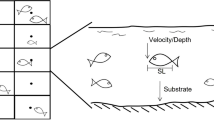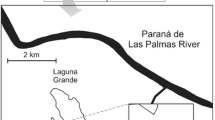Summary
Competition for water surface prey between fish (Priapichtus annectens: Poeciliidae) and water striders (Potamobates unidentatus: Gerridae) was studied in the laboratory and in pools in a small tropical stream. Laboratory experiments showed that fish depressed activity and foraging success of water striders. Large fish (4–5 cm) had a greater effect than small fish (2–3 cm). The field experiment showed that competition was highly asymmetric. Presence of fish decreased water strider foraging success while the reverse interaction was insignificant. It is suggested that the higher individual foraging success of the fish, harassment of water striders by fish and the use of an exclusive resource, benthic invertebrates, by the fish, contribute to this pattern. Habitat use differed between the two species. Fish used the deeper parts of stream pools and water striders used the shallower parts of the pools. Asymmetric interference and exploitation competition may force water striders to use shallow edge habitats.
Similar content being viewed by others
References
Andersen NM (1982) The semiaquatic bugs (Hemiptera, Geomorpha). Entomonograph Vol 3. Scandinavian Science Press, Klampenborg, Denmark
Bonnetto AA (1975) Hydraulic regime of the Parana river and its influence on ecosystems. Ecol Stud 10: 175–197
Brown JH, Davidson DW, Reichman OJ (1979) An experimental study of competition between seed-eating desert rodents and ants. Am Zool 19: 1129–1143
Bussing WA (1987) Pesces de las Aguas Continentales de Costa Rica. Editorial de la Universidad de Costa Rica, San Jose, Costa Rica
Carpenter FL (1979) Competition between hummingbirds and insects for nectar. Am Zool 19: 1105–1114
Cooper SD (1984) The effects of trout on water striders in stream pools. Oecologia 63: 376–379
Darwin C (1859) On the origin of species. Murray, London
Diamond J (1987) Competition among different taxa. Nature 326: 441
Diamond J, Case TJ (1986) Community ecology. Harper & Row, New York
Eriksson MOG (1979) Competition between freshwater fish and Goldeneyes Bucephala clangula (L.) for common prey. Oecologia 41: 99–107
Gilliam FF, Frazer DF (1988) Resource depletion and habitat segregation by competitors under predation hazard. In: Ebenman B, Persson L (eds) Size-structured populations. Springer Verlag, Berlin, pp 173–184
Gilpin ME, Case TJ (1976) Multiple domains of attraction in competition communities. Nature 261: 40–42
Hill D, Wrigh R, Street M (1986) Survival of Mallard ducklings Anas platyrhynchos and competition with fish for invertebrates on a flooded gravel quarry in England. Ibis 129: 159–167
Hochberg ME, Lawton JH (1990) Competition between kingdoms. Trends Ecol Evol 5: 367–371
Hurlbert SH, Loayza W, Moreno T (1986) Fish-flamingo-plankton interactions in the Peruvian Andes. Limnol Oceonogr 31: 457–468
Johansson ME, Keddy PA (1991) Intensity and asymmetry of competition between plant pairs of different degrees of similarity: an experimental study on two guilds of wetland plants. Oikos 60: 27–34
Kushlan JA (1976) Wading bird predation in a seasonally fluctuating pond. Auk 93: 464–476
Lauren JC, Kramer DL, Chapman CA (1991) Population dynamics of the fish Poecilia gillii (Poeciliidae) in pools of an intermittent tropical stream. J Anim Ecol 60: 441–453
Lawton JH, Hassel MP (1981) Asymmetrical competition in insects. Nature 289: 793–795
Levins R (1979) Asymmetric competition among distant taxa. Am Zool 19: 1097–1104
MacArthur RH (1972) Geographical ecology: patterns in the distribution of species. Harper & Row, New York
Morin PJ, Lawler SP, Johnson EA (1988) Competition between aquatic insects and vertebrates: interaction strength and higher order interactions. Ecology 69: 1401–1409
Persson L (1985) Asymmetrical competition: are larger animals competitively superior. Am Nat 126: 261–266
Pimm SL (1978) An experimental approach to the effects of predictability on community structure. Am Zool 18: 797–808
Power ME (1984) Depth distribution of armored catfish: predator-induced resource avoidance? Ecology 65: 523–528
Power ME (1987) Predator avoidance by grazing fishes in temperate and tropical streams: importance of stream depth and prey size. In: Kerfoot WC, Sih A (eds) Predation: direct and indirect impacts on aquatic communities. University Press of New England, Hanover, pp 333–351
Power ME, Matthews WJ, Stewart AJ (1985) Grazing minnows piscivouros bass and stream algae: Dynamics of a strong interaction. Ecology 66: 1448–1456
Rejmanek M, Stary P (1979) Connectance in real biotic communities and critical values for stability of model ecosystems. Nature 280: 311–313
Rummel JD, Roughgarden J (1983) Some differences between invasion-structured and coevolution-structured competitive communities: a preliminary theoretical analysis. Oikos 41: 477–486
Schluter D (1986) Character displacement between distant related taxa? Finches and bees in the Galápagos. Am Nat 127: 95–102
Schoener TW (1974) Resource partitioning in ecological communities. Science 185: 27–39
Schoener TW (1983) Field experiments on interspecific competition. Am Nat 122: 240–285
Spiller D, Schoener TW (1988) An experimental study of lizards on web-spiders community. Ecol Monogr 58: 57–77
Starret WC (1950) Distribution of the fishes Boone Country, Iowa, with special reference to the minnows and darters. Am Midland Nat 43: 112–127
Werner EE, Gilliam JF (1984) The ontogenetic niche and species interactions in size structured populations. Annu Rev Ecol Syst 15: 393–425
Wilkinson L (1988) SYSTAT: the system for statistics. Systat, Evanston, Ill
Williams R (1971) Fish ecology of the Kafue River and floodplain environment. Fish Res Bull Zambia: 305–330
Yodzis P (1986) Competition, mortality, and community structure. In: Diamond JM, Cody ML (eds) Community Ecology. Harper & Row, New York, pp 480–491
Author information
Authors and Affiliations
Rights and permissions
About this article
Cite this article
Englund, G., Johansson, F. & Olsson, T.I. Asymmetric competition between distant taxa: poecilid fishes and water striders. Oecologia 92, 498–502 (1992). https://doi.org/10.1007/BF00317841
Received:
Accepted:
Issue Date:
DOI: https://doi.org/10.1007/BF00317841




